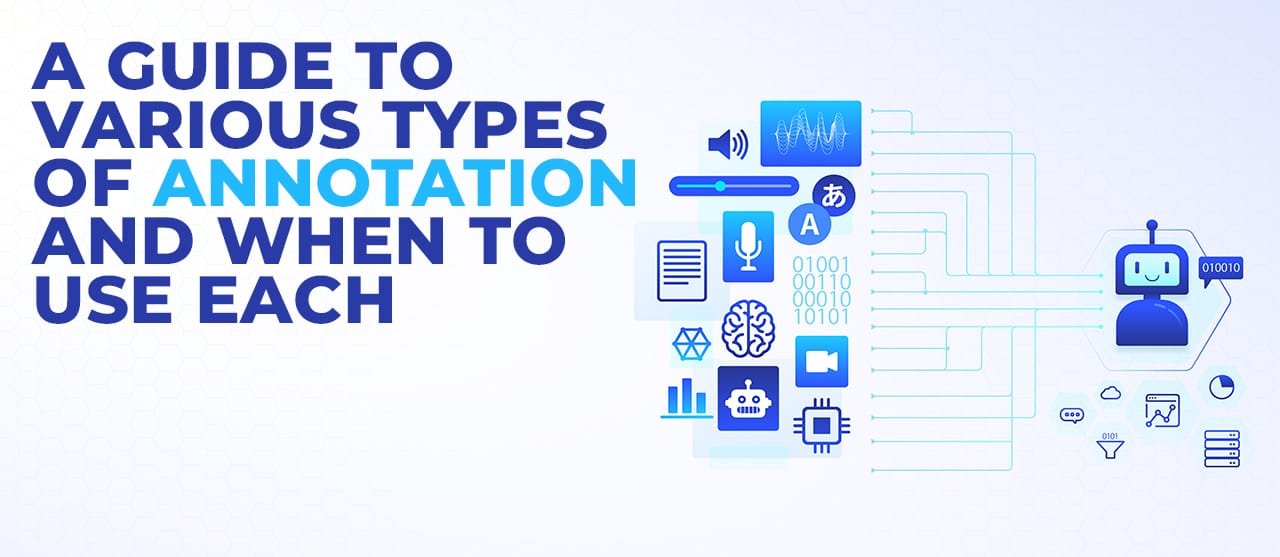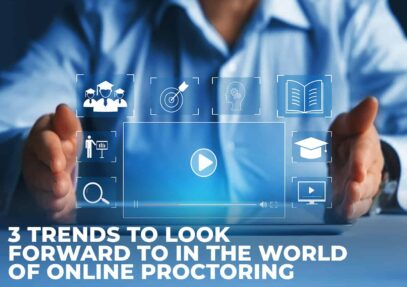
From logistics to IT and healthcare to retail, fully leveraging your organization’s data can be challenging. Fundamentally, data is required for comprehending and interpreting your reality. Data, as a result of an action, as a set of digital media, as the knowledge generated from a model, or as information retrieved from a sensor must be appropriately accessed, interpreted, prioritized, and leveraged to improve your business results.
Data annotation helps a Machine Learning (ML) algorithm identify the data it processes and determine its context. Thus, in computer science, annotation is a process of information labeling and tagging a given scenario with a special purpose for a given model. In 2022, the data annotation market was valued at $805.6 million; it’s projected to cross the $5.3 billion mark by the end of 2030.
Within this market, there are different methodologies of annotation catering to the diversity of data being generated online. Though the guiding factors for selecting appropriate annotation modes vary from project to project, there are some broad categories to consider to determine which ones are best suited for your next challenge.
This article seeks to provide a guide to various annotation methods based on various data types and when each should be used.
1. Textual or Linguistic Annotation
Textual annotation, within the ML context, helps develop metadata models and ontologies that focus on the extraction of lexical and semantic information from large volumes of data and assist in developing a text corpus. Some of the more common types of textual annotation involve parsing, sentence segmentation, chunking, named entity recognition, named entities extraction, part of speech tagging, lemmatization, parsing-surface realization relation identification, phonetic annotation, semantic role labeling, problem-oriented tagging, and discoursal annotation.
An example of linguistic annotation could be the labeling of tweets to establish the sentiment expressed, thus providing a categorization of their types (e.g., positive, negative, or neutral). In such a scenario, the data must reside in a structured format that is sensitive to the semantic content and properly handles various language modalities (e.g., English, German, French). This process is made easier with the help of text-processing tools. It also depends upon the dataset being accessed.
When To Use Textual Annotation?
In general, textual annotation is employed for the extraction of lexical and semantic information from large volumes of text. The following are some common scenarios that necessitate the use of linguistic metadata generation.
- When you are dealing with time-sensitive information such as tweets, chat logs, and news stories.
- When you want to develop a text corpus and related metadata models for NLP applications or question-answering systems or when developing automatic summarization algorithms that provide summaries as answers to specific questions.
- When you want to develop monitoring systems in a given domain in a particular language.
- When you need to develop a text- or document-level data mining system.
From a strictly linguistic perspective, textual annotation is used to generate metadata that corresponds to semantic categories of words/phrases, anaphoric links, thought presentation, the identity of a word, pronunciation of a word, etc.
2. Image Annotation
In computer vision, image annotation involves marking key points and regions of interest on a given image. It is a process of tagging visual media with a visual cue for a given model to interpret. Some of the annotation types include fixed-point detection, segmentation, object recognition, region clustering, etc.
An example of image annotation could be the labeling of objects in a scene, with emphasis on the identification of faces and human body parts. In such a scenario, it is critical that the annotator can precisely identify the salient features of the image being processed or supervised, thus allowing it to be used for training a model.
When To Use Image Annotation?
In technical terms, image annotation is used for landmarking, bounding boxes, transcription, and pixel-level labeling. From a business perspective, the following are the scenarios that require the use of image annotation:
- When you want to develop a human-oriented surveillance system, for example, for tracking individuals or monitoring the movement of vehicles.
- When you want to create a traffic sign detection system.
- When you need to provide labeling for atlases and manuals, with emphasis on the identification of objects about a particular topic.
- When you need to project the image for a computer graphics application, etc.
- When you want to develop a self-driving car that recognizes and responds to objects detected by its cameras.
3. Video Annotation
Video annotation, within the computer vision context, is employed for marking key points on a given video that can eventually be used to generate metadata about the content of the video. Some of the types of annotation include key-frame detection, structural segmentation, object detection, object recognition, etc.
An example of video annotation could be labeling a scene for a given service to recognize which objects are present and what actions they take. Such a case would demand the use of a combination of gazetteers and human-generated metadata, which would serve as training data for an automated model.
When To Use Video Annotation?
Video annotation’s technicalities encompass bounding 2D and 3D boxes, conceptualizing polygons, landmarking, and drawing lines and splines, among others. From the application perspective, video annotation can be used:
- For AR/VR content-based applications, identifying where to place virtual objects
- For video-based applications, tagging key events and interactions with the people in the scene
- For surveillance purposes, such as monitoring security cameras
- For spatial reasoning tasks like identifying point clouds and points of interest in a given scene
- For video evaluation, such as for face detection and recognition, tracking entities or events that appear to be of interest over time, etc.
4. Object Detection
A computer vision technique, object detection is used in digital image processing to identify objects in images or videos. As a key output of deep learning and machine learning algorithms, object detection helps spot people, objects, scenes, and visual details in images or videos.
The goal of object detection is to teach a computer what comes naturally to humans: to gain a decent level of understanding of what an image contains. As a subset of object recognition, it helps in identifying an object and also locating it in the image or video.
When To Use Object Detection?
Object detection plays a key role in driverless cars, disease identification, industrial inspection, and more. Here are some use cases:
- When you want to detect people in the image or video streams as part of video surveillance
- When you want to analyze how or which aisles people shop in a store for the purpose of customer needs analysis
- When you want to count animals on a farm or check the cause of damaged produce
- When you want to check the number plates of suspicious vehicles, say at an airport or a restricted industrial setting.
5. Semantic Segmentation
As a deep learning algorithm, semantic segmentation associates a label with every pixel in an image. It works to recognize a collection of pixels that form distinctive categories. As compared to object detection, where objects have to fit a bounding box, semantic segmentation viably detects irregularly shaped objects.
When To Use Semantic Segmentation?
Semantic segmentation’s labeling capabilities make it a perfect choice for applications in a variety of industries that require precise image maps. Here are some scenarios where semantic segmentation can be used:
- When you want to identify and navigate objects, for example, in autonomous vehicles to separate the road from obstacles such as vehicles, pedestrians, sidewalks, traffic light signals, etc.
- When you want to detect defects in materials such as manufacturing equipment.
- When you want to identify terrains such as mountains, rivers, fields, or deserts via satellite imagery.
- When you want to analyze and detect medical conditions, such as identifying cancerous anomalies in cells.
6. Instance Segmentation
A special type of image segmentation, instance segmentation detects and segments every object in an image, even if multiple objects of the same class are present. In the sphere of computer vision, it helps in segregating instances of objects in a complex visual environment and in demarcating their boundaries. Unlike semantic segmentation, which cannot differentiate the same objects in one image as different, instance segmentation will do it seamlessly.
When To Use Instance Segmentation
Instance segmentation is particularly useful when distinct objects of related types are present and need to be monitored separately. Popular use cases include:
- When you want to have a detailed understanding of your surroundings with pixel-level accuracy, for example, in a self-driving car.
- When you want to segregate objects from one another, say, cargo ships from passenger ships for maritime security purposes.
- When you want to categorize items, for example, clothing in a retail store.
7. Panoptic Segmentation
Panoptic segmentation is a type of image annotation that combines the prediction from semantic segmentation and instance segmentation into a unified output. As the name suggests, it analyzes everything visible in a given visual field while also identifying things like background and unannotated objects and holistically generalizes the task of image segmentation.
In computer vision, the task of panoptic segmentation can be broken down into three basic steps: separating each object in the image into individual parts, labeling each separated part, and classifying them.
When To Use Panoptic Segmentation?
Since panoptic segmentation identifies objects according to class labels and instances in any given image, it is used across various applications, such as:
- When you are dealing with large volumes of visual data that is difficult to interpret, say while recognizing tumor cells.
- When you want to identify and classify objects in an image, for example, a traffic surveillance camera to determine the cause of an accident.
- When you want to simultaneously detect countable objects with different backgrounds, say in an urban setting.
8. Keypoint Annotation
The keypoint annotation takes a detailed approach to image annotation and is used to detect small objects and shape variations. You can use keypoint annotation to label a single pixel in an image and portray an object’s shape.
When To Use Keypoint Annotation?
Keypoint annotations are well-suited for tracking the movements of objects, people, or animals. Popular use cases include:
- When you want to track variations between objects which have the same structure, for example, human or facial features.
- When you want to analyze the performance of players by tracking and analyzing performance improvements not visible to the human eye.
- When you want to track or analyze human poses, say in an AR/ VR application.
- When you want to detect the hand movements of workers, say in a manufacturing setup.
- When you want to track the movement of livestock on a farm.
9. Multi-Label Classification
Multi-label classification allows you to assign multiple labels or classes to a single image. With the large surge in digital images, this type of classification allows for an efficient way to analyze, annotate, and manipulate image data.
Unlike traditional classification, which involves predicting a single label, multi-label classification involves predicting the likelihood across two or more class labels that are mutually exclusive. This means the classification task assumes the input belongs to a single class only.
When To Use Multi-label Classification?
Multi-label classification is becoming increasingly popular due to the increasing number of different real-world application domains, such as:
- When you want to categorize text documents.
- When you want to carry out a detailed medical diagnosis.
- When you want to categorize music to unearth the underlying emotion.
Conclusion
The ubiquitous nature of data has created the need for automated information discovery systems capable of achieving enhanced accuracy and precision to cater to ever-growing intrinsic business complexity. Considering that, it is imperative that information scientists and researchers who engage in such practices be familiar with all the schemes of annotation and the related processes that accompany them.
As such, it is necessary to consider the various forms of annotation and then experiment with the numerous features and options available and select techniques that best suit any given situation. Connect with EnFuse Solutions to scale and optimize the data annotation processes.

















Comment